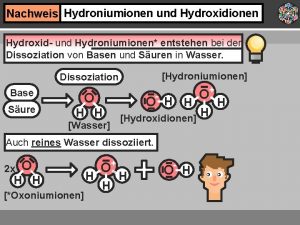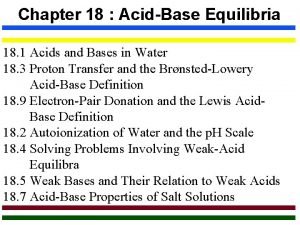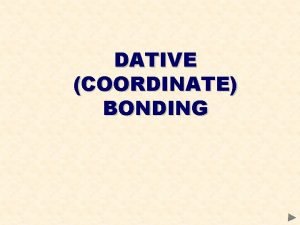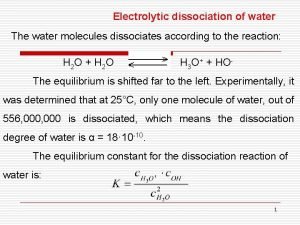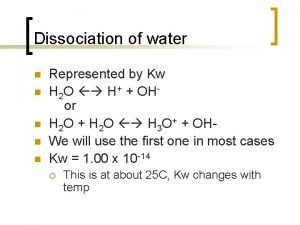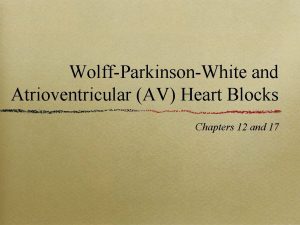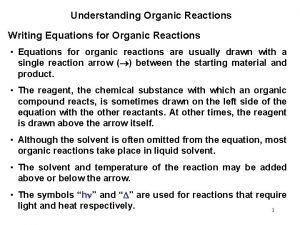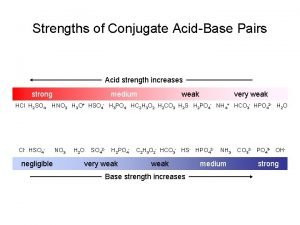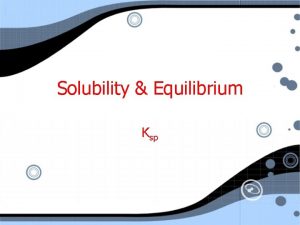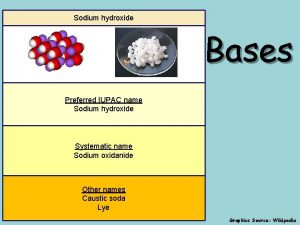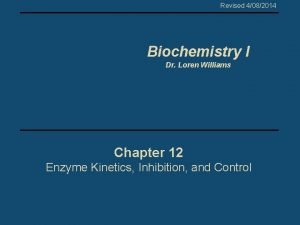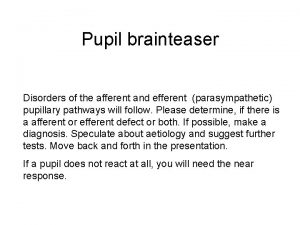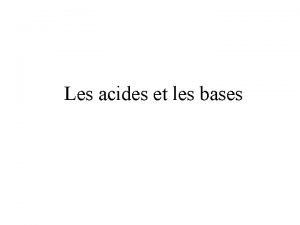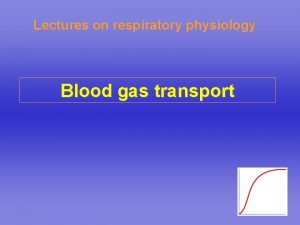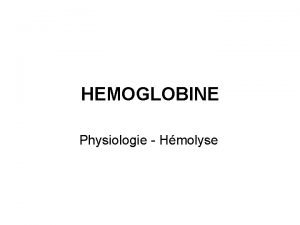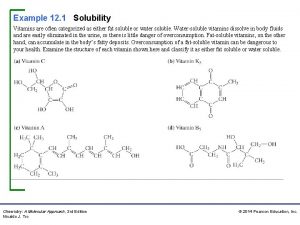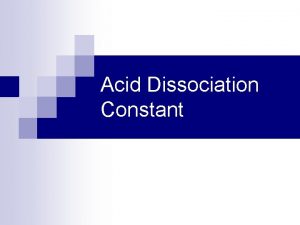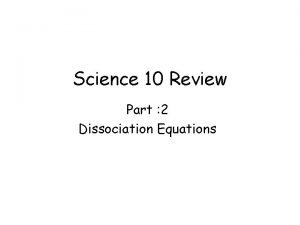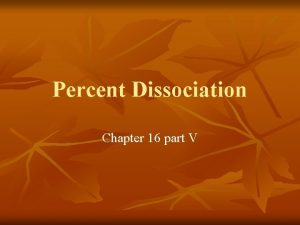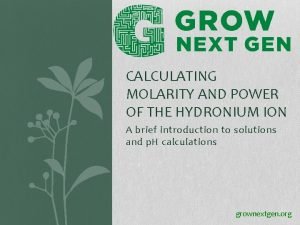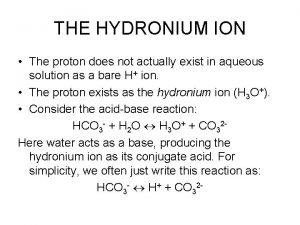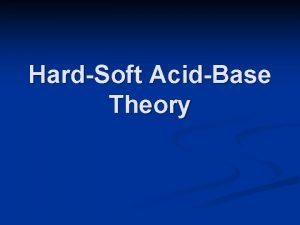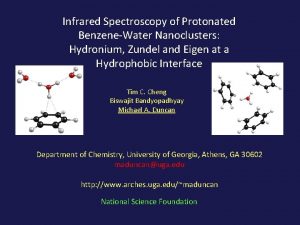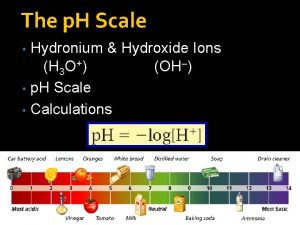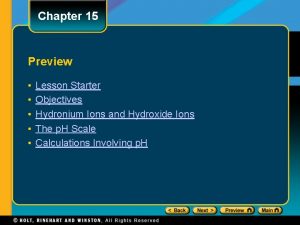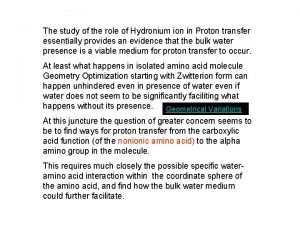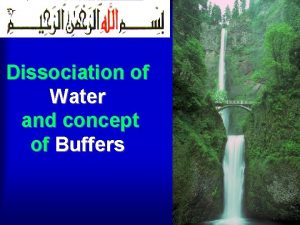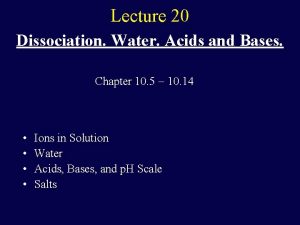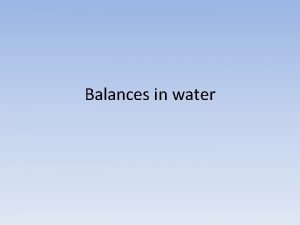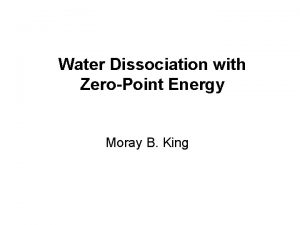Dissociation of water and p H Hydronium and




















- Slides: 20

Dissociation of water and p. H

Hydronium and Hydroxide • Water most typically exists as H 2 O, two Hydrogens bonded to a single Oxygen • But the polar covalent bonding structure of the water poses some special instabilities • When you have two water molecules, the Oxygen on one of them may become more attractive to the other’s Hydrogen, and may remove that proton and take it itself


Hydronium continued • They will continue to pass that proton back and forth as long as there is no interference from any dissolved solutes • The two molecules, Hydronium (H 3 O+) and Hydroxide (OH-) exist at equilibrium only in pure water (such as distilled) • 2 H 2 O ⇋ H 30+ + OH • H 3 O+ decomposes into an H 2 O and an H+, and the H+ may be picked up by an OH-, if one is available

Electrolytes and Hydrogen • When an ionic solute is dissolved in water (or another molecule with a polar covalently bonded Hydrogen, or a molecule with an available lone pair), it may interfere with the equilibrium of the reaction 2 H 2 O ⇋ H 30+ + OH • Such cases result in a net increase in the relative concentrations of either the Hydronium or the Hydroxide radicals

Changes in H+ concentration • The concentration of Hydrogen+ ions is measured as the power of Hydrogen, or p. H • The concentration of Hydronium relative to H 20 in pure water is measured to average 10 -7 moles/liter, the (absolute value) log of this is 7 • So in pure water, the p. H is 7 • As the Hydrogen ion concentration increases, the p. H decreases (10 -6 is greater than 10 -7, 10 -5 is greater than 10 -6, and so on) • So a solution with a p. H of 5 has 10 times as many free H+ ions than a solution with a p. H of 6!

The p. H scale • • • 0 < 7 < 14 Less than 7 is an acid (acidic) 7 is neutral Greater than 7 is a base (alkali, caustic, basic) Most of biology involves p. H values close to neutral

Example 1: an increase in H 3 O+ • Consider the following substance: Hydrogen Chloride (HCl) • Chlorine is a highly electronegative element, thus the bond between H and Cl is very polar • In water, this is a very unstable bond and easily broken by the water molecule • When this happens, water deprotonates the HCl, resulting in an H 3 O+ and a Cl-

Acids and strong acids • Any substance, that when dissolved in water, increases the net concentration of H+ ions, is an acid • HCl dissolves in water because water removes the proton (Hydrogen) from Chlorine to form H 3 O+ • Chlorine as an ion (Cl-) is stable in water, attracting many water molecules around it (Hydrogen poles of water molecules attracted to the strong negative charge of the Chlorine) • But the Chlorine does not have the strength to pull the proton back from water, so it remains a negative ion • Because it remains a negative ion, and does not take a Hydrogen back, HCl is a strong acid (it completely disassociates in water)

Water is an acid and a base • H 2 O can donate a proton to another water molecule, forming an H 3 O+ and an OH • The donating H 2 O is acting as an acid • The H 2 O that received the proton did so by deprotonating the other H 2 O. It was therefore acting as a base • H 3 O+ can contribute a proton to a solution, so it is acid (very strong acid) • OH- removes protons from a solution, so it is a base (very strong base)

Weak acids • Vinegar (acetic acid) also gives up a Hydrogen ion to water, but is much less likely to do so than HCl • On average, 100 out of every 100 HCl molecules becomes deprotonated in water to form Hydronium and Cl • Only about 1 out of every 100 acetic acids become deprotonated to form Hydronium and Acetate, the rest remain protonated • Acetate can—and often does—take its proton back • Because acetic acid is less likely to contribute to a net increase in Hydronium concentration, it is a weak acid • In other words, acetic acid is stable in water, which makes it a weak acid. HCl is instable, which makes it a strong acid

Acetate, a critical biological molecule

Bases and strong bases • Any substance that when dissolved in water results in a decrease in the concentration of Hydrogen ions is a base • Substances that have weak electronegativity tend to be bases • Consider Na. OH: this dissolves in water to form Na+ and OH-. • The OH- rapidly removes any H+ ions in a systems, because it is much more attractive to those ions than H 2 O—and the H+ ions are much easier to bond with than the original Na+. • Na. OH completely disassociates in water, and as such is a strong base

Weak bases • Any base that does not completely disassociate in water may only remove a few H+ from a solution • Ammonia (NH 3), for example, is an important biological base. • It has a lone pair, with which it may form polar bonds to Hydrogen ions to form ammonium (NH 4+)


Conjugates • Any substance, whether acid or base is built around a molecule called a conjugate • The conjugate has a negative charge, and in water may be protonated • Conjugates that remain negative charged in water and do not accept protons (unless there a LOT of available protons) tend to be strong acids • Conjugates that easily accept protons (unless there a VERY FEW available) tend to be strong bases

Conjugates

Conjugate • A conjugate is the molecule that either accepts or donates a proton from/to water • A conjugate plus a proton is called an acid (because it can donate that proton), the conjugate minus its proton is a base (because it can take a proton)

Characteristics of conjugates • For every conjugate, there is a range of p. H at which it takes (removes) protons from water, and a range at which it will give up a proton to water if it has one to give up • There is special equilibrium point (p. H) at which, for a given conjugate, it is as likely to accept a proton or donate a proton. • In other words, the protonated and deprotonated form of the conjugate exist in equal concentrations • This value is its acid disassociation constant, or Ka • This is commonly referred as the p. Ka

End of section Gets more difficult coming up—and you’ll need a calculator…
 Water and water and water water
Water and water and water water Nachweis hydroniumionen
Nachweis hydroniumionen 7 strong acid
7 strong acid Ka and kb
Ka and kb Carbon monoxide dative covalent bond
Carbon monoxide dative covalent bond Dissociated meaning
Dissociated meaning Water dissociation
Water dissociation Av dissociation
Av dissociation Bond dissociation energy table
Bond dissociation energy table Strength of conjugate base
Strength of conjugate base Iodate solubility
Iodate solubility Honh2 dissociation equation
Honh2 dissociation equation Kcat equation mcat
Kcat equation mcat Bask model of dissociation
Bask model of dissociation Isocoric pupil means
Isocoric pupil means Base forte
Base forte Co2 dissociation curve
Co2 dissociation curve Kathleen martin emdr
Kathleen martin emdr Toleransfönster
Toleransfönster Courbe de dissociation de l'hémoglobine
Courbe de dissociation de l'hémoglobine Site:slidetodoc.com
Site:slidetodoc.com

